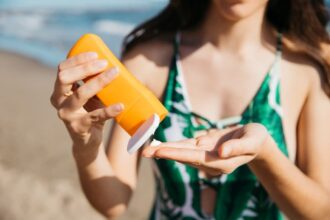Still using creams that barely scratch the surface?
Most over-the-counter antifungal creams can’t penetrate thick or discolored nails—leaving the infection lurking underneath.
The risk?
Untreated nail fungus can spread fast: to other toes, shared showers, even your family. It’s not just a cosmetic issue—it’s contagious.
The smarter alternative:
Antifungal nail paints. These paint-on treatments use FDA-listed actives like ciclopirox or tolnaftate to target fungus deep inside the nail—while letting you cover up damage at the same time. No one has to know you’re treating it.
👇 Below, we break down how they work, which formulas are doctor-backed, and exactly how to apply them for faster, visible results.
What Makes a Nail Paint “Antifungal”?
Not all nail paints are created equal. Many products marketed for “healthy nails” are actually just cosmetic polishes—they may mask discoloration but do nothing to kill fungus.
Real antifungal nail paints are classified as OTC drugs in the U.S. This means they contain FDA-approved active ingredients, are required to list these on a Drug Facts panel, and must meet strict safety and efficacy standards.
These therapeutic lacquers penetrate the nail plate to deliver medication where it’s needed most: beneath the surface, where the fungus lives.
Common FDA-listed actives found in antifungal nail treatments include:
🔬 Key Actives & Their Potency
| Active Ingredient | Typical Strength | How It Works |
| Ciclopirox | 8% | Antifungal + anti-inflammatory |
| Tolnaftate | 1% | Fungistatic; slows spread |
| Undecylenic Acid | 25% | Disrupts fungal cell membranes |
💡 Look for a Drug Facts panel on the label. If it’s missing, you’re buying a cosmetic—not a treatment.
Best Antifungal Nail Paints 2025
Ready to treat your nails without ditching polish altogether? Below are our top 3 antifungal nail paint treatments for 2025—tested, compared, and podiatrist-reviewed. Whether you want overnight ease or a liquid solution that reaches tough spots, there’s something here that works.
🔍 Quick Comparison Table
🧪 Product Reviews & What to Expect
Not all antifungal nail paints are created equal—and not every product works the same for every user. Below, we’ve broken down the top 3 options from our shortlist, highlighting how each one performs in real use, what conditions it’s best suited for, and what to realistically expect over the first few weeks.
To evaluate these antifungal nail paints, we focused on what matters most for at-home users:
- Realistic Use Window: Each product was assessed over a 6-week period for signs of visible improvement—like reduced discoloration and smoother nail surface.
- Formula & Application: We compared how easy each one was to apply, whether it dried quickly, and how well it fit into a daily routine.
- Ingredients & Claims: We reviewed each formula’s active antifungal agents and cross-checked claims with FDA monographs and user feedback.
- Best for Overnight Ease: Opti-Nail Patch — apply, sleep, forget.
- Best for Athlete’s Foot Combo: Fungi-Nail Ointment — works on skin + nails.
- Best for Severe Discoloration: FUNGINIX — max strength + deep cuticle reach.
- Budget Choice: Fungi-Nail again — top results without breaking the bank.
- Runner-Friendly: FUNGINIX — dries fast, no greasy residue in shoes.
The links above may earn HealiScope a small commission at no extra cost to you. This helps keep our content free, unbiased and doctor-reviewed.
Let’s break it down.
Night-Time Treatment Improves Nail Appearance While You Sleep (21 Patches)
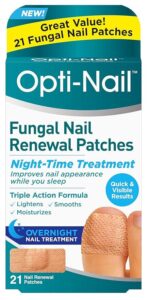
A convenient, mess-free way to care for fungus-damaged toenails overnight—ideal for anyone who wants visible improvement without using liquid lacquers.
- Application type: Patch
- Main benefit: Fungal nail renewal + brightening
- Treatment duration: Overnight
- Patch count: 21 patches
- Visible effect: Improves nail clarity & moisture
- No polish needed
- Best for: Night-time convenience
This patch system is perfect for users who don’t want to deal with brush-on liquids or strong-smelling formulas. The triple-action approach lightens, smooths, and hydrates nail beds—all while you sleep. It’s one of the few options that treats and brightens nail appearance without daily maintenance.
✅ Pros
✔️Hands-free, mess-free treatment
✔️Moisturizing formula improves texture
✔️Great for travel or night use
✔️Lightens discoloration gently
✔️No polish or drying time required
❗Cons
⛔Doesn’t treat fungus at the root (cosmetic results only)
⛔May take weeks to show visible changes
⛔Less effective for thick, deeply infected nails
This is not an FDA-listed antifungal drug—it’s a cosmetic renewal system. Ideal if you want visual improvement but not a full medical-grade treatment. For deep or persistent infections, combine with oral or lacquer-based antifungals.
Clinically Proven Tolnaftate Treatment + Essential Oils (0.7 oz)
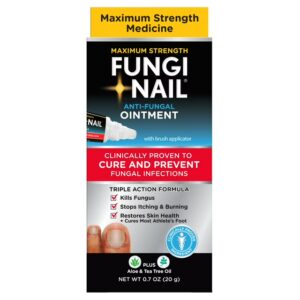
A dual-purpose antifungal ointment that treats both nail fungus and athlete’s foot—perfect for users who need broad coverage and skin restoration in one.
- Type: Ointment
- Active ingredient: Tolnaftate 1%
- Application: Brush-on (dual-angle applicator)
- Extras: Tea tree oil, aloe vera, lavender
- Spectrum: Skin + nail antifungal
- Size: 0.7 fl oz
- Use case: Nail edges, athlete’s foot, itchy skin
This isn’t just for toenails. Fungi Nail’s ointment is ideal for anyone dealing with both nail fungus and skin irritation like athlete’s foot. The angled brush makes it easy to target hard-to-reach spots under the nail. Bonus: it includes soothing natural oils like tea tree and aloe for added relief.
✅ Pros
✔️Dual-use: nails and surrounding skin
✔️Easy applicator reaches under nail
✔️Includes five essential oils
✔️Soothes itch, burning & irritation
✔️Great for athlete’s foot crossover users
❗ Cons
⛔May leave a slight residue on skin
⛔Not ideal for applying under polish
⛔Ointment format = less portable
This product shines when your infection spreads beyond the nail. But if you’re looking to wear polish while treating, a lacquer format may be better. Combine with proper hygiene (dry socks, aired shoes) for faster results.
Max Strength Antifungal Liquid (2 Bottles – USA Made)
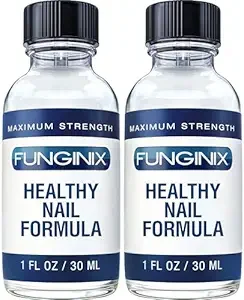
A potent, no-nonsense liquid treatment with deep-penetrating ingredients for stubborn nail fungus—ideal for users who want natural but strong results.
- Type: Liquid solution
- Active ingredient: Undisclosed proprietary blend (NDC 71229-102-11)
- Application: Dropper tip for base & edge of nail
- Frequency: Twice daily
- Includes: 2 bottles (1 fl oz each)
- Formulated in: USA
Funginix has developed a strong fanbase for a reason—it goes on clear, penetrates fast, and works without harsh chemical smell or residue. We especially liked its focus on skin absorption around the cuticle, where fungus often thrives unnoticed. It’s natural, clean, and backed by user satisfaction.
✅ Pros
✔️Twice-daily formula with no reported irritation
✔️Dropper applicator = no mess, no waste
✔️Made in the USA with consistent quality
✔️Natural-based with no artificial dyes or perfumes
✔️Generous 2-bottle pack = great value
❗ Cons
⛔Requires patience and consistent use
⛔Label doesn’t disclose specific active %
⛔Might not suit those seeking instant results
This is a go-to option if you’re dealing with persistent fungal discoloration or want a natural-first approach. Keep in mind: like all topical treatments, full results may take several months depending on nail growth speed and severity.
Step-by-Step: Applying Antifungal Paint for Maximum Penetration
To actually reach the fungus hiding under thick, hardened nails, how you apply antifungal paint matters as much as what’s in it.
Follow this 5-step routine for maximum absorption and faster results:
Use sanitized clippers to trim the nail. Then gently file the surface with a disposable emery board to reduce thickness and remove buildup.
Wipe nails with an alcohol pad or cotton ball. This clears oil and debris, allowing better drug penetration.
Paint a narrow band around the nail edge and cuticle—the fungus often lurks here. Let dry for at least 60 seconds.
Swipe the brush along the nail tip. This helps block moisture, which fuels fungal growth.
Use the paint every night, and once a week, wipe the nail clean with alcohol before reapplying. This prevents product buildup.
💡 Pro tip: Use a separate file for each infected nail to avoid cross-contamination.
Can You Wear Regular Polish Over Antifungal Lacquer?
Yes—but only with specific precautions. If you’re using a lacquer with ciclopirox, you can layer color polish on top, but it must be removed and reapplied daily to let the treatment work effectively.
Other formulations (like tolnaftate or undecylenic acid liquids) should generally be used solo, without cosmetic polish, for best results.
💡 Always check the product instructions. Some lacquers are not designed to work under colored polish and may lose potency.
🟨 Quick FAQ:
Can I paint my toenails if I have fungus?
Yes, but only over certain antifungal lacquers like ciclopirox—and only if you’re committed to daily removal and reapplication. Otherwise, polish can trap moisture and worsen the infection.
How Long Until Fungus Clears? Real-World Timeline
Toenail fungus doesn’t vanish overnight—even with the best antifungal nail paint. On average, full clearance for a big toenail takes 9–12 months, depending on the severity and how consistently you apply treatment.
A 2023 clinical review in the Journal of the American Podiatric Medical Association found that visible improvement typically begins within 6–8 weeks, but complete nail regrowth is what determines full recovery.
🚨 Tip: Don’t stop treatment just because symptoms improve early. Fungus may still be active beneath the surface.
Signs the Nail Fungus Is Dying
🟢 Color lightens — Yellow or brown tints start fading toward pinkish-white.
🟢 No new debris — Fungal buildup under the nail stops accumulating.
🟢 Reduced odor — A cleaner, neutral scent is a sign of reduced fungal activity.
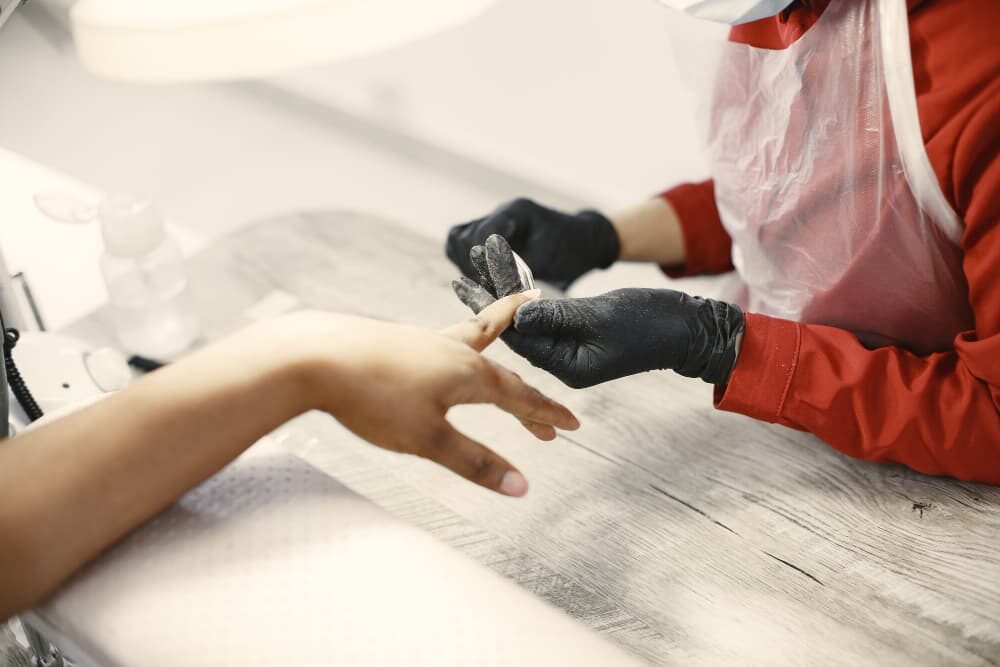
What Permanently Kills Nail Fungus? (When Paint Isn’t Enough)
Antifungal nail paints can work—especially in early-stage cases. But if your fungus is deep, persistent, or spreading despite months of treatment, you may need stronger options.
The goal shifts from managing symptoms to eradicating the infection at its source. Here’s what podiatrists recommend when topical solutions fall short:
1. Oral Terbinafine (Prescription Pill)
Often the first-line systemic treatment. Terbinafine targets the fungus from within, carried through the bloodstream to the nail bed.
- Duration: Typically 6–12 weeks
- Effectiveness: Up to 76% cure rate (source: BMJ Clinical Evidence)
- Warning: Liver enzyme monitoring may be required
💊 Ask your podiatrist whether oral antifungals are suitable—especially if you have liver conditions or take other medications.
2. Laser Therapy (FDA-Cleared Devices)
High-intensity light pulses destroy fungal cells without harming surrounding tissue.
- Pros: Painless, no downtime
- Cons: Not always covered by insurance, multiple sessions may be needed
- Estimated Cost: $500–$1,500 (see our cost guide)
3. Debridement (Professional Nail Removal or Thinning)
A podiatrist trims or grinds down the infected nail to reduce fungal load and let medications penetrate deeper.
- Method: In-office trimming or partial removal
- Used with: Topical or oral treatments
- When necessary: Thick, crumbling nails or severe buildup
If you’ve used antifungal nail paint for 8+ weeks with no visible change, it may be time to combine therapies or consult a foot care specialist.
🦶 Still unsure which option fits you? The next section helps you prevent re-infection after treatment.
Prevention Playbook: 7 Things Not to Do With Nail Fungus
Treating fungus is just the first step. Without the right habits, it can easily return—or spread to others.
Here are 7 common mistakes to avoid during and after treatment:
Even among family, this spreads spores. Use separate tools and disinfect after every use.
Fungus loves warm, wet floors. Wear flip-flops in locker rooms and shared bathrooms.
Sweaty, closed footwear creates the perfect environment. Choose breathable materials and rotate your shoes daily.
Moist socks = fungal fuel. Always change into dry, clean socks right after sweating.
Wearing clean cotton socks to bed can reduce spread—especially if you share your bed or live with others.
💬 Common Q: Should I wear socks to bed with nail fungus?
Yes—soft, breathable socks help limit transmission to sheets and surfaces.
Fungi can survive inside shoes. Use antifungal sprays or UV sanitizers weekly.
Even if your nail looks better, fungus may still be active. Stick with your treatment until fully grown out (6–12 months for toenails).
✅ Tip: A few smart hygiene upgrades can make a big difference. Nail fungus is stubborn, but with prevention, it doesn’t have to come back.
FAQ – Rapid Answers
Yes, especially if they contain FDA-listed actives like ciclopirox or tolnaftate. These lacquers penetrate the nail plate better than creams and are most effective when applied consistently for several months.
Early signs include fading discoloration, reduced nail debris, smoother texture, and less odor. It can take weeks to notice change—don’t stop treatment until new, healthy nail growth is clearly visible.
Fungi can survive in old polish bottles, especially if shared or contaminated. It’s best to discard polish used on infected nails and avoid salon polish if you’re dealing with fungus.
There’s anecdotal support for vinegar soaks, but no strong clinical evidence. Vinegar may help slightly lower pH and reduce spread, but it’s not a substitute for medical antifungal treatments.
It’s not recommended. Salons can unintentionally spread fungus if tools or footbaths aren’t properly sanitized. Wait until the infection clears, or request a medical-grade pedicure from a podiatrist’s office.
If there’s no improvement after 6–8 weeks, consult a podiatrist. You may need oral antifungals or laser therapy, especially for severe or deep infections that topical treatments can’t reach.
Yes. While less common, toenail fungus can transfer to fingernails through shared tools, towels, or direct contact—especially if immunity is low or hands are exposed to moisture often.
The Bottom Line
Antifungal nail paint is a discreet, effective way to treat nail fungus—especially when used consistently and correctly. With FDA-listed ingredients like ciclopirox or tolnaftate, these lacquers help kill the fungus while letting you maintain normal nail appearance. For severe or stubborn cases, medical-grade options may be needed. More product picks & rewievs.
Disclaimer: This content is for informational purposes only and does not replace professional medical advice. Always consult a licensed podiatrist or dermatologist before starting any new treatment, especially for persistent or painful nail conditions.



